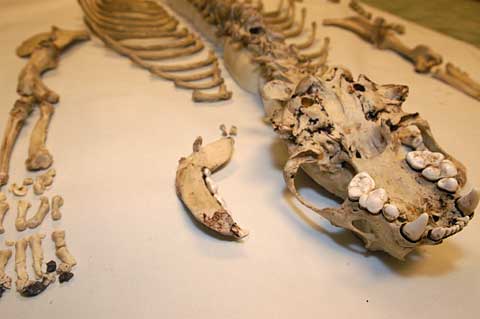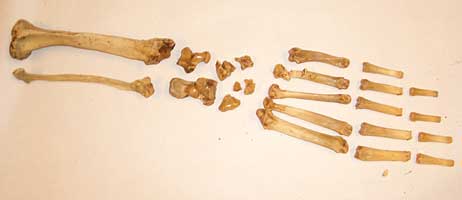Multidisciplinary Collaboration
They call themselves “the bone gang,” and a glance around the anthropology lab tells you why. There are dozens of specimen boxes on the tables and shelves, and on the floor—carefully arranged on a sheet of canvas—are the skeletal remains of “Baby,” the sea otter fondly nicknamed and meticulously studied by biology majors Brittany Murray ’05 and Jillian Sprance ’05.

For three years, Murray and Sprance analyzed sea mammal bones with Professor of Anthropology Lucy Johnson (pictured) to study the diet and adaptations of the prehistoric hunter-gatherers living in the Aleutian Islands of coastal Alaska from 3,000 to 500 years ago.
By analyzing thousands of bones from an archaeological site in Alaska, Johnson and her students determined which species of mammal the Aleuts ate as well as how they butchered them and even the ways they used the bones as tools. “Our work revealed that the prehistoric hunters we were studying had focused their efforts on sea otters,” Johnson says, “and we had to have a way to calculate this prey’s food value.”

The bone gang doesn’t just operate out of the anthro lab. For the last three summers, Murray and Sprance participated in 10-week summer sessions through the Vassar Ford Scholars Program (funding collaborative scholarship with faculty) and the Undergraduate Research Summer Institute (URSI—where Vassar students work one-on-one with Vassar scientists doing original hands-on scientific research). They attended research conferences in Seattle and Washington, DC, and over spring break they returned to the Northwest to present the results of their nutrient analysis at the annual meeting of the Alaskan Anthropological Association in Anchorage.
Murray chose Vassar to study science in part because she wanted to really participate in hands-on research and “not just wash test tubes or put numbers into a computer…. Being a science major at Vassar has allowed me to get fantastic research experience and to interact with faculty on a meaningful level so that I could get the most out of my science classes.”

Sprance’s enlistment in the bone gang was a fluke. As a transfer student from Mount Holyoke, Sprance realized that she had requested the wrong courses two days before classes started for her first semester at Vassar. “I had to pick mostly new classes, and—while I was looking—happened to get an email that Lucy Johnson had sent out seeking student researchers interested in identifying mammal bones. Since I’ve always been fascinated by bones, I decided to take her “Function and Evolution of the Human Skeleton” class, and I’ve been coming to ‘bone class’ ever since.”
Sprance says that Johnson has been her most influential professor. “Her willingness to involve students in research has truly transformed my experience here. There are so many opportunities to get involved with research in different sciences at Vassar. And biology here is not just a place full of narrow-minded pre-meds who only want to learn about vertebrate biochem or structure and physiology. There are professors here who work on things like bioinformatics, robotics, biomechanics, genetics, and microbiology, to name a few. Also, as Brittany and I can attest, there is ample opportunity to do in-depth study of a field outside of your major!”
